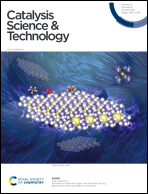Selective Photocatalyst for styrene epoxidation with atmospheric O2 using covalent organic frameworks†
Abstract
Biomimetic catalysis has been widely studied due to its environmentally friendly nature. In this work, Fe@POG-OH, comprising a plurality of iron–catechol-like catechol dioxygenases, was synthetized and used to photocatalyze styrene epoxidation with high selectivity and high conversion at room temperature. According to various spectroscopic and experimental results, it was revealed that Fe@POG-OH enables the activation of atmospheric O2 to O2˙−, playing a crucial role in the effective and selective oxidation of styrene to styrene oxide (100% yield and 94% selectivity). A possible mechanism for the oxidation of styrene was proposed and investigated using DFT calculations to better understand the reaction path. The occurrence of spin crossing makes it possible to catalyze the cycle under light. The main path to generate styrene oxide is more energy efficient than the side path that generates benzaldehyde and formaldehyde, which is consistent with the experimental results. This article reports the influence of the difference in spin multiplicity on the ring formation of the side pathway for the first time, which provides guidance for investigations of the catalytic calculations of Fe coordination unsaturated complexes.



 Please wait while we load your content...
Please wait while we load your content...